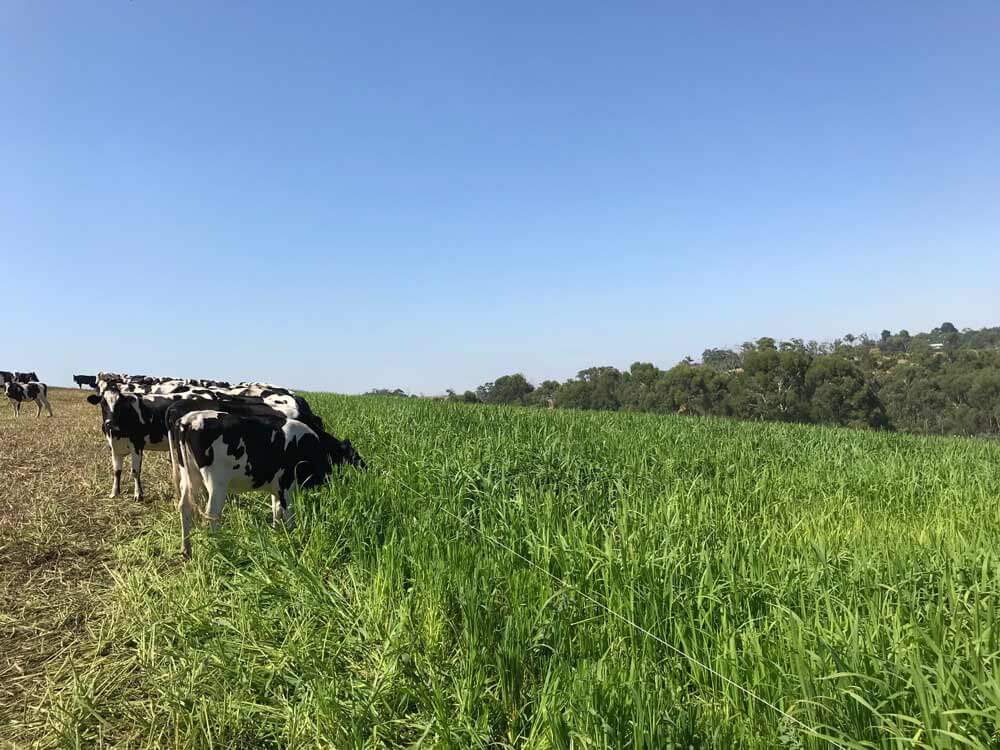WHY FORAGE CROPS?
Establishment of summer forage will continue to grow in southern areas with:
- Increased stocking rates with pastures tending to degrade faster
- Prolonged dry periods forcing farmers to conserve more fodder and/or grow more home-grown feed.
- High irrigation efficiency of forage varieties compared to pasture
- Opportunity to incorporate lime and fertiliser nutrients into the soil and upgrade the pasture once the crop is utilised.
- Value for money
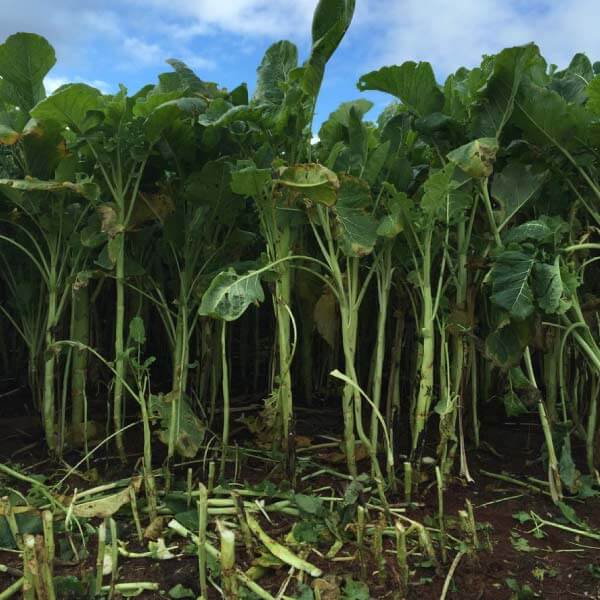
SELECTING A FORAGE
Important discussion aspects when selecting a forage crop
[table width ="100%" style ="" responsive ="false"]
[table_head]
[th_column]Forage Crop[/th_column]
[/table_head]
[table_body]
[table_row]
[row_column]
Ensuring that the pasture is not out of the grazing rotation for too long
The forage chosen should be established in spring whilst moisture is available, with the land drilled back to pasture by mid-March (Gippsland), early April (Western District). This will still allow for a potential spring silage cut, as well as ensuring sufficient moisture and heat for the re-drilled pasture to grow before the next winter.
[/row_column]
[/table_row]
[table_row]
[row_column]
Value for money?
Choosing a forage crop that produces the best yield and quality for the money invested.
[/row_column]
[/table_row]
[table_row]
[row_column]
Crop Maturity
The forage of choice must be able to deliver the forage when it is most needed (i.e. early or late in dry period) provided moisture is available
[/row_column]
[/table_row]
[table_row]
[row_column]
Single or Multi Graze?
Adopting both single & multi–graze management strategies with selected crops can help solve forage shortages later in season.
[/row_column]
[/table_row]
[table_row]
[row_column]
Minimal herbicide and insecticide input
The residual activity of pre-emergent herbicides controls the first few flushes of germinating weeds while the crop is too small to compete. Good planning is needed to use pre-emergent herbicides as an effective tactic.
[/row_column]
[/table_row]
[table_row]
[row_column]
Cultivation post crop
Will area need further cultivation before going back to pasture? A crop requiring no further soil cultivation before drilling back to pasture can be advantageous (i.e. Chicory)
[/row_column]
[/table_row]
[table_row]
[row_column]
Moisture requirements
Does forage crop tolerate sporadic rain, regular moisture or irrigation for summer growth.
[/row_column]
[/table_row]
[table_row]
[row_column]
Animal Health Issues
Does crop present potential animal health issues such as choking, nitrate, bloat etc.
[/row_column]
[/table_row]
[/table_body]
[/table]
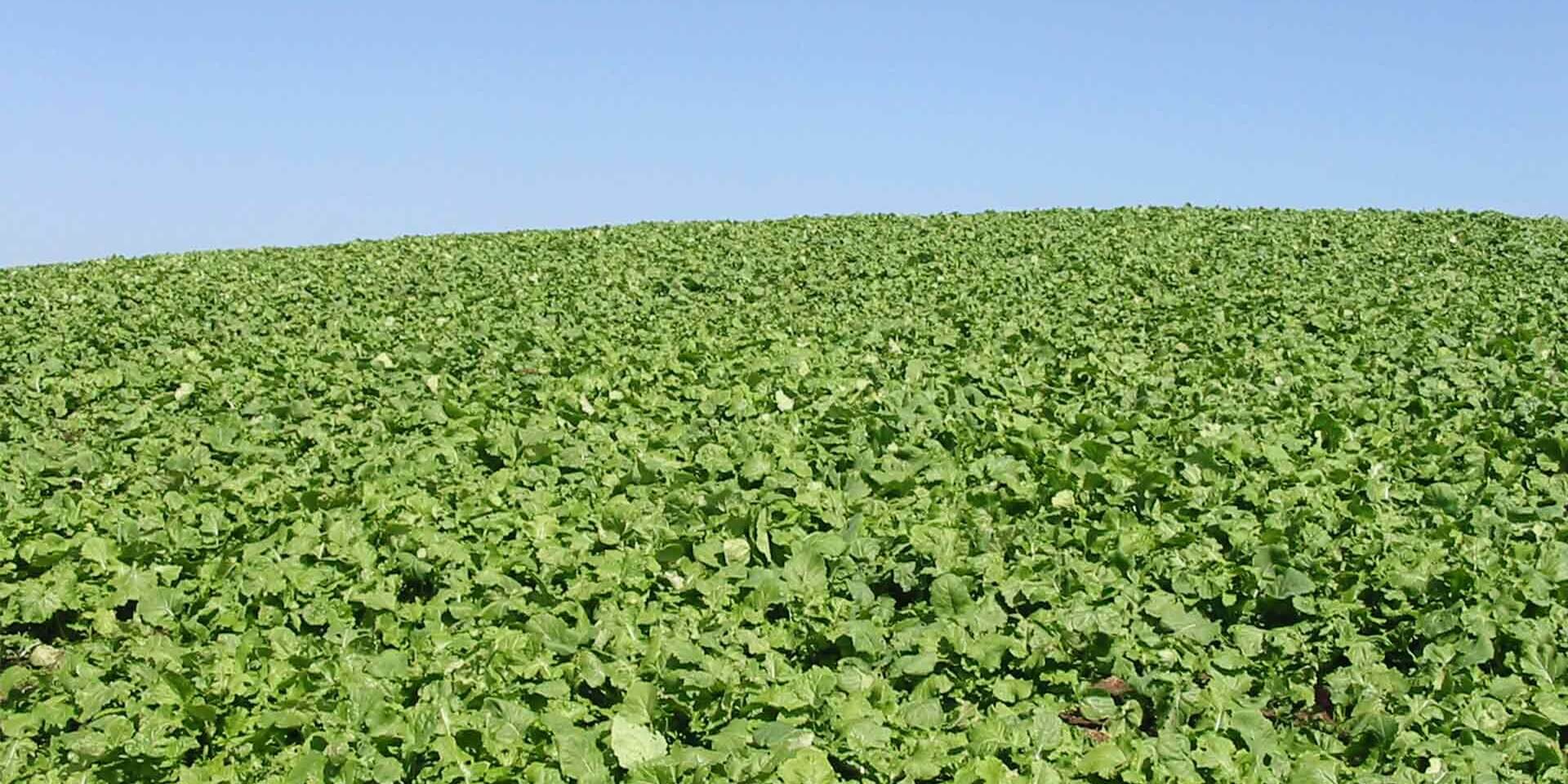
AGRONOMY COMPARISON
| CROP | AGRONOMY | READY TO GRAZE | GRAZING | SOWING RATE |
| Chicory | Bi-annual, Drought tolerance, high ME and palatability, insect pest tolerant, robustness. Late Summer & Autumn Feed. Low maintenance. | 50-70 days | Multi | 6-10 kg/ha (standalone)2-4 kg/ha (Top Crop blend) |
| Plantain | Year round production in pasture mix. High ME & mineral content, fibrous root system, Drought & heat tolerant, persistent, grows well on low fertile soils | 50-70 days | Multi | 8-10 kg/ha (standalone)1-2 kg/ha (Top Crop Blend) |
| Kale | A late autumn winter feed, very high dry matter, fill feed requirements when pasture low | 150-200 days | Multi | 4-7 kg/ha (standalone) |
| Turnip | Fast maturing, High yielding, high quality & utilisation. Ready to graze: 60-75 days (Marco) 70-90 days (Barkant) 90-110 days (MPT) | 60-110 day options | Single | 1-3 kg/ha (standalone)0.5 kg/ha (Top Crop blend) |
| Leafy Turnip | Fastest brassica option. Fast maturing, high quality, multi graze option, minimal ripening required | 42-70 days | Multi | 3-6 kg/ha (standalone)1-2 kg/ha (Top Crop blend) |
| Forage Rape | Drought tolerant, good response to later summer/autumn rains. Leafy giant type (Pillar), high yielding, multi graze 2-4, strong re-growth potential, good disease resistance | 70-110 days (Pillar) 60-90 days (Titan) |
Multi | 3-6 kg/ha (Standalone) 1-3 kg/ha(Top Crop blend) |
| Millet | Bulk growth, low cost, fast growing, no prussic acid, excellent water efficiency, high yielding | 45-60 days | Multi | 20-30 kg/ha (standalone)10-20 kg/ha (Top Crop blend) |
| Sorghum & Sudan Grass | Strong early yield. Quality & drought tolerance slightly better than Millet. Fast establishment, drought tolerance, water efficiency, suited to grazing, hay and round bale silage | 45-60 days | Multi | 15-30 kg/ha (standalone) |
MULTI SPECIE FORAGE CROPS
[table width ="100%" style ="" responsive ="false"]
[table_head]
[th_column]Multi specie[/th_column]
[th_column]Cultivars[/th_column]
[/table_head]
[table_row]
[row_column]Top Crop Brassica & Herbs[/row_column]
[row_column]Forage Rape, Leafy Turnip, Chico Chicory & Red Clover[/row_column]
[/table_row]
[table_row]
[table_row]
[row_column]Top Crop Brassica, Herbs & Millet[/row_column]
[row_column]Chicory, Forage Rape & Forage Millet[/row_column]
[/table_row]
[table_row]
[row_column]Top Crop Millet & Rape[/row_column]
[row_column]Forage miller, Forage Rape[/row_column]
[/table_row]
[table_row]
[row_column]Top Crop Millet & Brassica[/row_column]
[row_column]Forage Millet, Forage Rape, Leafy Turnip[/row_column]
[/table_row]
[table_row]
[row_column]Top Crop Millet & Pasja II[/row_column]
[row_column]Forage Millet, Leafy Turnip[/row_column]
[/table_row]
[table_row]
[row_column]Multi Species Long Term Blend[/row_column]
[row_column]Perennial Ryegrass, Cocksfoot, Prairie Grass, Red Clover, White Clover, Subterranean Clover, Balansa Clover, Chicory, Plantain, Leafy Turnip[/row_column]
[/table_row]
[table_row]
[row_column]Summer Forage Multi Species Blend[/row_column]
[row_column]Forage Millet, Forage Sorghum, Forage Rape, Leafy Turnip, Chicory, Plantain, White Clover, Red Clover, Forage Radish[/row_column]
[/table_row]
[table_row]
[row_column]Winter Multi Species Blend[/row_column]
[row_column]Forage Oats, Diploid Annual Ryegrass, Ryecorn, Winter turnip, Arrowleaf clover, Balansa Clover, Shaftal Clover, Forage Radish[/row_column]
[/table_row]
[table_row]
[row_column]Green Manure Multi Species Blend[/row_column]
[row_column]Forage Oats, Diploid Annual Ryegrass, Ryecorn, Vetch[/row_column]
[/table_row]
[/table]
* Results will vary depending on all circumstances.
FEED COMPARISON (SPRING-MAY)
[table width ="100%" style ="" responsive ="false"]
[table_head]
[th_column]Forage Crop[/th_column]
[th_column]Potential t/DM[/th_column]
[th_column]Typical energy (MJME/kg DM)[/th_column]
[th_column]Typical protein % CP[/th_column]
[/table_head]
[table_row]
[row_column]Ryegrass Pasture[/row_column]
[row_column]6-8t/ha[/row_column]
[row_column]10.5[/row_column]
[row_column]18-20%[/row_column]
[/table_row]
[table_row]
[table_row]
[row_column]Chicory[/row_column]
[row_column]6-12t/ha[/row_column]
[row_column]12+[/row_column]
[row_column]18-24%[/row_column]
[/table_row]
[table_row]
[row_column]Plantain[/row_column]
[row_column]6-8t/ha[/row_column]
[row_column]10-12[/row_column]
[row_column]16-28%[/row_column]
[/table_row]
[table_row]
[row_column]Turnips[/row_column]
[row_column]6-10t/ha[/row_column]
[row_column]13[/row_column]
[row_column]12%[/row_column]
[/table_row]
[table_row]
[row_column]Leafy Turnips[/row_column]
[row_column]6-8t/ha[/row_column]
[row_column]12-14[/row_column]
[row_column]12%[/row_column]
[/table_row]
[table_row]
[row_column]Forage Rape[/row_column]
[row_column]8-10t/ha[/row_column]
[row_column]12[/row_column]
[row_column]14%[/row_column]
[/table_row]
[table_row]
[row_column]Kale[/row_column]
[row_column]14t/ha[/row_column]
[row_column]12 (leaf)[/row_column]
[row_column]17.3% leaf, 6% stem[/row_column]
[/table_row]
[table_row]
[row_column]Millet[/row_column]
[row_column]10t/ha[/row_column]
[row_column]9[/row_column]
[row_column]11%[/row_column]
[/table_row]
[table_row]
[row_column]Sorghum[/row_column]
[row_column]10-12t/ha[/row_column]
[row_column]9-10.5[/row_column]
[row_column]10-16%[/row_column]
[/table_row]
[/table]
* Results will vary depending on all circumstances.
VARIETY COMPARISON - COMMENTS
Dependent on a variety of factors, including environment, planting time, stock needs & water availability, there is a range of varieties available to suit your needs.
[table width ="100%" style ="" responsive ="false"]
[table_head]
[th_column]Forage Crop[/th_column]
[th_column]Description[/th_column]
[/table_head]
[table_body]
[table_row]
[row_column]Forage Brassicas[/row_column]
[row_column]
Are an extremely valuable, high protein, highly digestible feed source— offering establishment into cooler soils & the ability to mix pasture herbs and clovers into your summer forage blends.
[/row_column]
[/table_row]
[table_row]
[row_column]Top Crop Forage Blends[/row_column]
[row_column]
Are an excellent summer/spring option, producing high quality, high yielding, reliable feed during the summer period when normal pasture quality and production is declining.[/row_column]
[/table_row]
[table_row]
[row_column]Chicory[/row_column]
[row_column]
Is a highly palatable forage that is an excellent feed source for high livestock growth rates from late spring to late autumn.. It provides high quality feed through summer using summer rain, irrigation or stored soil water. With it’s long and fibrous root system allowing the plant to draw moisture and minerals from deep within the soil, the drought tolerance
[/row_column]
[/table_row]
[table_row]
[row_column]Plantain[/row_column]
[row_column]
Provides good year round growth and high quality feed.
[/row_column]
[/table_row]
[table_row]
[row_column]Kale[/row_column]
[row_column]
A late autumn/winter feed that delivers a single graze option in May to August. Extremely high crop utilisation. Kale has a deep root system and therefore good drought tolerance once established.
[/row_column]
[/table_row]
[table_row]
[row_column]Forage Sorghum & Millet[/row_column]
[row_column]
With the right conditions—heat, moisture & fertility—can deliver strong early growth & large quantities of highly digestible dry matter. Irrigation is usually required for best performance.
[/row_column]
[/table_row]
[table_row]
[row_column]Maize[/row_column]
[row_column]Varieties suitable for both irrigation or dryland, deliver outstanding grain and silage yields with disease tolerance, stalk strength & balanced diets by providing good quality fibre, low protein while maintaining relatively good levels of energy.
[/row_column]
[/table_row]
[/table_body]
[/table]
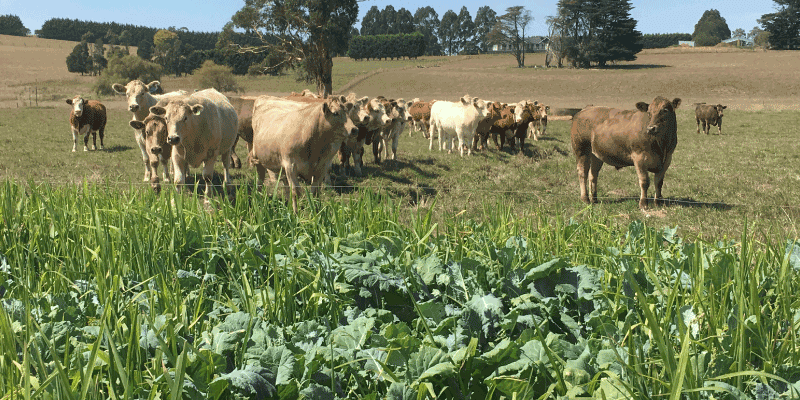
SINGLE OT MULTI GRAZE?
Selecting a forage crop based on your needs this season.
[table width ="100%" style ="" responsive ="false"]
[table_head]
[th_column]Grazing[/th_column]
[th_column]Varieties[/th_column]
[/table_head]
[table_body]
[table_row]
[row_column]Single Graze[/row_column]
[row_column]Tankard-type Turnips including Barkant, Marco Tetraploid Turnip, Mammoth Purple Top, Kale[/row_column]
[/table_row]
[table_row]
[row_column]Multi-Graze[/row_column]
[row_column]Leafy Turnips including Pasja II Leafy Turnip, Appin Leafy Turnip, Forage Rape including Pillar Forage Rape, Titan Forage Rape, Chicory including Chico Chicory or Puna II Chicory, Plantain including Oracle Plantain [/row_column]
[/table_row]
[/table_body]
[/table]
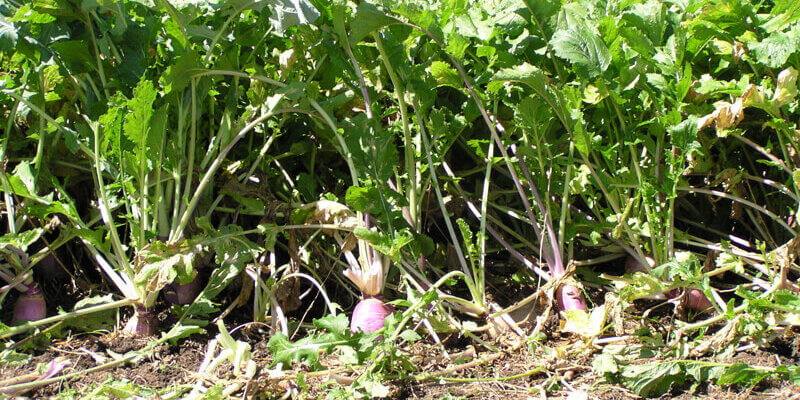
READY TO GRAZE?
[table width ="100%" style ="" responsive ="false"]
[table_head]
[th_column]Ready to Graze[/th_column]
[th_column]Varieties[/th_column]
[/table_head]
[table_body]
[table_row]
[row_column]42-70 days[/row_column]
[row_column] Pasja II Leafy Turnip, Appin Leafy Turnip,[/row_column]
[/table_row]
[table_body]
[table_row]
[row_column]50-70 days[/row_column]
[row_column]Marco Tetraploid Turnip, Chico Chicory [/row_column]
[/table_row]
[table_row]
[row_column]70-90 days[/row_column]
[row_column]Barkant Turnip, Pillar Forage Rape, Titan Forage Rape[/row_column]
[/table_row]
[table_row]
[row_column]90-120 days[/row_column]
[row_column]Mammoth Purple Top, Goliath Forage Rape[/row_column]
[/table_row]
[table_row]
[row_column]120+ days[/row_column]
[row_column]Fodder Beet, Regal Kale, Coleor Kale[/row_column]
[/table_row]
[/table_body]
[/table]
MOISTURE REQUIREMENTS
[table width ="100%" style ="" responsive ="false"]
[table_head]
[th_column]Forage Crop[/th_column]
[th_column]Moisture requirement[/th_column]
[/table_head]
[table_body]
[table_row]
[row_column]Turnips, Forage Rape[/row_column]
[row_column]Tolerates sporadic rain[/row_column]
[/table_row]
[table_body]
[table_row]
[row_column]Leafy Turnips[/row_column]
[row_column]Requires consistent moisture[/row_column]
[/table_row]
[table_row]
[row_column]Kale[/row_column]
[row_column]high for high yields[/row_column]
[/table_row]
[table_row]
[row_column]Maize, Millet[/row_column]
[row_column]Consistent moisture for high yields[/row_column]
[/table_row]
[/table_body]
[/table]
PEST AND WEED MANAGEMENT
Pests and weeds infestations can results in significant crop losses and should be checked and sprayed if necessary. Pre-emergent herbicide applications and ongoing crop monitoring is recommended to maximise the DM/ha performance.
[table width ="100%" style ="" responsive ="false"]
[table_head]
[th_column]Forage Crop[/th_column]
[th_column]Insect pest include:[/th_column]
[/table_head]
[table_body]
[table_row]
[row_column]Brassica[/row_column]
[row_column]Aphid, Cockchafer, Cutworm, Diamondback moth, Cabbage moth, Earthmite, Lucerne Flea, Slugs, Snails, White Butterfy[/row_column]
[/table_row]
[table_row]
[row_column]Chicory[/row_column]
[row_column]Red Legged Earthmite, Lucerne Flea, Red headed cockchafer, Slugs, Snails[/row_column]
[/table_row]
[table_row]
[row_column]Plantain[/row_column]
[row_column]Earthmites, Slugs, Snails[/row_column]
[/table_row]
[table_row]
[row_column]Kale[/row_column]
[row_column]Diamondback moth, White butterfly, Aphids[/row_column]
[/table_row]
[table_row]
[row_column]Millet & Forage Sorghum[/row_column]
[row_column]Aphid, Armyworm, Black Field Crickets, Cutworm, Wireworm (false & true)[/row_column]
[/table_row]
[table_row]
[row_column]Maize[/row_column]
[row_column]African black beetle, Aphids, Armyworm, Black field crickets, Black field earwigs, Corn Earworm, Cutworm, Slugs, Snails, Wireworm (false & true)[/row_column]
[/table_row]
[/table_body]
[/table]
[table width ="100%" style ="" responsive ="false"]
[table_head]
[th_column]Forage Crop[/th_column]
[th_column]Weeds include:[/th_column]
[/table_head]
[table_body]
[table_row]
[row_column]All forage crops[/row_column]
[row_column]Pre and/or post emergent herbicide control of annual & summer grass & weeds.[/row_column]
[/table_row]
[/table_body]
[/table]
**All information in this publication is general in nature. Although the information in this publication is believed to be accurate, no liability (whether as a result of negligence or otherwise) is accepted for any loss of any kind that may arise from actions based on the contents of this publication.







